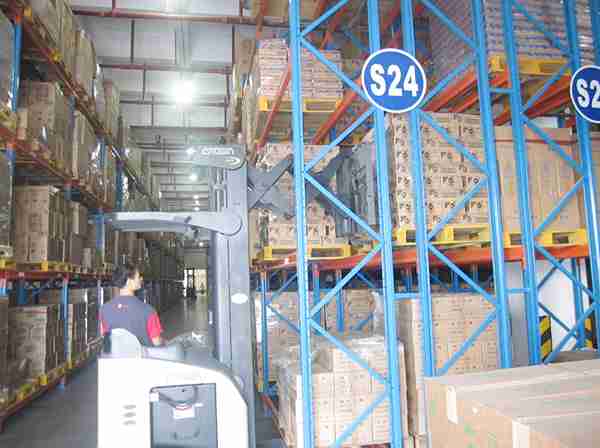📐 "First 50 Enterprise Queries Get Custom 3D Warehouse Design" Plan

Introduction: Why Double Deep Racking Load Limits Matter
In high-density warehousing, double deep racking maximizes space by storing pallets two-deep. However, ignoring double deep racking load limits can lead to catastrophic failures, OSHA violations, and costly operational shutdowns.
This guide dives deep into:
- How double deep racking load limits are calculated
- Structural factors that impact capacity (beams, uprights, flooring)
- Real-world consequences of exceeding load limits
- Best practices for compliance with RMI, OSHA, and FEM standards
By the end, warehouse managers, safety officers, and logistics planners will know exactly how to optimize storage without compromising safety.

H1: What Is Double Deep Racking? (And Why Load Limits Are Critical)
Double deep racking is a space-saving pallet storage system where two pallets are stored back-to-back, requiring specialized reach trucks or double-deep forklifts for retrieval.
H2: The Physics Behind Double Deep Racking Load Limits
Unlike selective racking, double deep racking load limits must account for:
- Increased forward force (due to deeper storage)
- Higher beam deflection risk (since pallets are further from uprights)
- Forklift access challenges (requiring precise weight distribution)
Ignoring these factors is why many warehouses experience rack collapses.
H1: How to Calculate Double Deep Racking Load Limits
Every racking system has a maximum safe load capacity, but actual usable limits depend on multiple variables.
H2: Manufacturer’s Specifications (The Starting Point)
- Beam capacity ratings (e.g., 8,000 lbs per pair)
- Upright frame strength (thicker steel = higher capacity)
- Anchoring requirements (must resist lateral forces)
Pro Tip: Always request engineered load drawings from your rack supplier.
H2: The Role of Uniformly Distributed Load (UDL) in Double Deep Racking
- Ideal weight distribution = even across both beams
- Uneven loads create tipping hazards
- Maximum deflection should not exceed L/180 (per RMI standards)
H2: How Forklifts Affect Double Deep Racking Load Limits
- Dynamic loading (sudden impacts) reduces safe capacity by 15-20%
- Side-shifting forklifts add lateral stress
- Solution: Train operators on slow, controlled placements
H1: Industry Standards for Double Deep Racking Load Limits
Compliance isn’t optional—OSHA fines for overloaded racks can exceed $100,000.
H2: RMI/ANSI MH16.1 – The Gold Standard
- Requires 1.5x safety factor over stated capacity
- Mandates annual inspections by qualified personnel
H2: OSHA 1910.176(b) – Warehouse Storage Rules
- No modifications without approval
- Damaged components must be replaced immediately
H2: FEM 10.2.02 – European Best Practices
- More conservative than U.S. standards
- Requires 2x safety margins for dynamic loads
Non-compliance risks insurance denial in case of accidents.
H1: 5 Deadly Mistakes That Exceed Double Deep Racking Load Limits
H2: Mistake #1 – Assuming “Close Enough” Is Safe
- Example: A 7,500-lb load on an 8,000-lb beam seems fine—until forklift impact pushes it over.
- Fix: Maintain at least 10% buffer below max capacity.
H2: Mistake #2 – Mixing Beam Types
- Using mismatched beams (e.g., lighter-duty beams in high-traffic zones)
- Result: Premature fatigue fractures
H2: Mistake #3 – Ignoring Floor Conditions
- Weak concrete cracks under point loads
- Solution: Test floor PSI before installation
H2: Mistake #4 – Overlooking Pallet Quality
- Broken pallets shift weight unpredictably
- Best Practice: Enforce pallet inspection protocols
H2: Mistake #5 – Skipping Inspections
- Bent uprights reduce capacity by 30%+
- Compliance Tip: Use checklist-based weekly audits
H1: Best Practices to Stay Within Double Deep Racking Load Limits
H2: Rule #1 – Label Every Beam with Max Loads
- Visual reminders prevent guesswork
- Use color-coded tags for different zones
H2: Rule #2 – Implement a Weight Verification System
- Digital load sensors flag overloads in real-time
- Manual alternative: Random pallet weigh-ins
H2: Rule #3 – Train, Train, Train
- Forklift drivers cause 60% of rack overloads
- Monthly refreshers reduce errors
H2: Rule #4 – Reinforce High-Risk Areas
- Upgrade to structural racking for heavy loads
- Add cross-bracing in earthquake-prone regions
H1: Case Study: When Double Deep Racking Load Limits Were Ignored
Company: Eastern Logistics LLC
Issue: Stacked 9,000 lbs on 8,000-lb beams to “save time.”
Result:
✅ Week 1: No issues
✅ Week 3: Minor beam deflection
❌ Week 6: Catastrophic collapse – $250K in damages + OSHA fines
Lesson: Double deep racking load limits aren’t suggestions—they’re laws of physics.
H1: How to Choose the Right Double Deep Racking System
H2: Option 1 – Standard Duty (Up to 6,000 lbs/level)
- Best for: Light-to-medium inventory (e.g., retail goods)
H2: Option 2 – Heavy Duty (Up to 15,000 lbs/level)
- Best for: Dense products (metal parts, automotive)
H2: Option 3 – Structural Racking (20,000+ lbs/level)
- Best for: Industrial machinery storage
Key Question: “What’s the heaviest pallet we’ll ever store—and at what frequency?”
H1: Conclusion – Double Deep Racking Load Limits Are Non-Negotiable
Ignoring double deep racking load limits risks lives, inventory, and legal liability. By:
✔ Following manufacturer specs
✔ Training staff rigorously
✔ Enforcing weight checks
…warehouses can boost storage density safely.
Need a racking safety audit? [Contact our engineers] for a free load capacity assessment.
FAQs: Double Deep Racking Load Limits
1. Can I reinforce beams to increase double deep racking load limits?
No. Unapproved modifications void warranties and increase collapse risks.
2. How do I know if my floor can handle double deep racking?
Core test concrete (minimum 3,500 PSI for heavy-duty racks).
3. What’s the #1 cause of double deep racking failures?
Overloading + forklift abuse.
4. Do seismic zones affect double deep racking load limits?
Yes. California warehouses need 20%+ higher safety margins.
5. How often should I replace rack components?
Immediately if bent, cracked, or corroded.
This article includes stereo.




